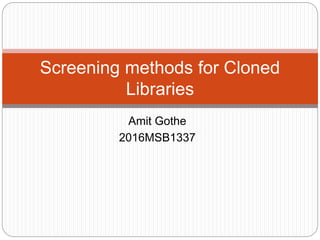Screening methods for cloned libraries
•Als PPTX, PDF herunterladen•
11 gefällt mir•3,728 views
Different methods by which genes are screened. The identification of specific clone from a library can be carried out.
Melden
Teilen
Melden
Teilen

Empfohlen
Empfohlen
Weitere ähnliche Inhalte
Was ist angesagt?
Was ist angesagt? (20)
bacterial artificial chromosome & yeast artificial chromosome

bacterial artificial chromosome & yeast artificial chromosome
Lectut btn-202-ppt-l23. labeling techniques for nucleic acids

Lectut btn-202-ppt-l23. labeling techniques for nucleic acids
Ähnlich wie Screening methods for cloned libraries
Ähnlich wie Screening methods for cloned libraries (20)
Principle and procedure for making Genomic library and cDNA library.pptx

Principle and procedure for making Genomic library and cDNA library.pptx
DNA SEQUENCING METHODS AND STRATEGIES FOR GENOME SEQUENCING

DNA SEQUENCING METHODS AND STRATEGIES FOR GENOME SEQUENCING
Kürzlich hochgeladen
Kürzlich hochgeladen (20)
Vip profile Call Girls In Lonavala 9748763073 For Genuine Sex Service At Just...

Vip profile Call Girls In Lonavala 9748763073 For Genuine Sex Service At Just...
❤Jammu Kashmir Call Girls 8617697112 Personal Whatsapp Number 💦✅.

❤Jammu Kashmir Call Girls 8617697112 Personal Whatsapp Number 💦✅.
Feature-aligned N-BEATS with Sinkhorn divergence (ICLR '24)

Feature-aligned N-BEATS with Sinkhorn divergence (ICLR '24)
Pests of mustard_Identification_Management_Dr.UPR.pdf

Pests of mustard_Identification_Management_Dr.UPR.pdf
TEST BANK For Radiologic Science for Technologists, 12th Edition by Stewart C...

TEST BANK For Radiologic Science for Technologists, 12th Edition by Stewart C...
Call Girls Alandi Call Me 7737669865 Budget Friendly No Advance Booking

Call Girls Alandi Call Me 7737669865 Budget Friendly No Advance Booking
GUIDELINES ON SIMILAR BIOLOGICS Regulatory Requirements for Marketing Authori...

GUIDELINES ON SIMILAR BIOLOGICS Regulatory Requirements for Marketing Authori...
Nightside clouds and disequilibrium chemistry on the hot Jupiter WASP-43b

Nightside clouds and disequilibrium chemistry on the hot Jupiter WASP-43b
Hire 💕 9907093804 Hooghly Call Girls Service Call Girls Agency

Hire 💕 9907093804 Hooghly Call Girls Service Call Girls Agency
Screening methods for cloned libraries
- 1. Amit Gothe 2016MSB1337 Screening methods for Cloned Libraries
- 2. Introduction A DNA library is a collection of DNA fragments that have been cloned into vectors so that researchers can identify and isolate the DNA fragments that interest them for further study. There are basically two kinds of libraries: genomic DNA and cDNA libraries. Genomic DNA libraries contain large fragments of DNA in either bacteriophages or bacterial or P1-derived artificial chromosomes (BACs and. PACs). cDNA libraries are made with cloned, reverse-transcribed mRNA, and therefore lack DNA sequences corresponding to genomic regions that are not expressed, such as introns and 5′ and 3′ noncoding regions. cDNA libraries generally contain much smaller
- 3. Library Screening The identification of specific clone from a DNA library can be carried out by exploiting either: 1. the sequence of the clone or 2. the structure/function of its expressed product. Former type can be applied to genomic or cDNA libraries and nucleic acid hybridization is done with the help of probes or primers. Screening the product of a clone is applied only to expression libraries where the DNA fragment is expressed to yield proteins and the product is recognized by Ab/ligand.
- 4. Sequence dependent Screening Screening by Hybridization Nucleic acid hybridization is most commonly used method and it is rapid. Developed by Grunstein and Hogness (1975). This method is widely used in isolating Recombinant phage particles. Thus, hybridization has potential to isolate any sequence if probe is available. Variation of this method devised by Benton is called Plaque lift method.
- 6. PCR Screening The PCR is widely used to isolate specific DNA sequences from uncloned genomic DNA and now it has been a useful technique for library screening. This method was first demonstrated by takumi and Lodish in 1994. The molecular weight of known members of the family can be predicted and novel mRNAs may give rise to amplification products. It is more stringent since three oligonucleotides (the two PCR primers, and the hybridization probe) are required to give a true positive signal.
- 8. South-western and North-western Screening A plaque lift is carried out to transfer a print of the library onto nitrocellulose membrane. Here screening is carried out by incubating radio labelled double stranded DNA oligonucleotide probe containing recognition sequence for the DNA-binding protein. Combines the principles of southern and western blots. It has been particularly successful in the isolation of clones expressing cDNA sequences. Alternatively ligands can be used to identify polypeptides that specifically bind certain molecules.